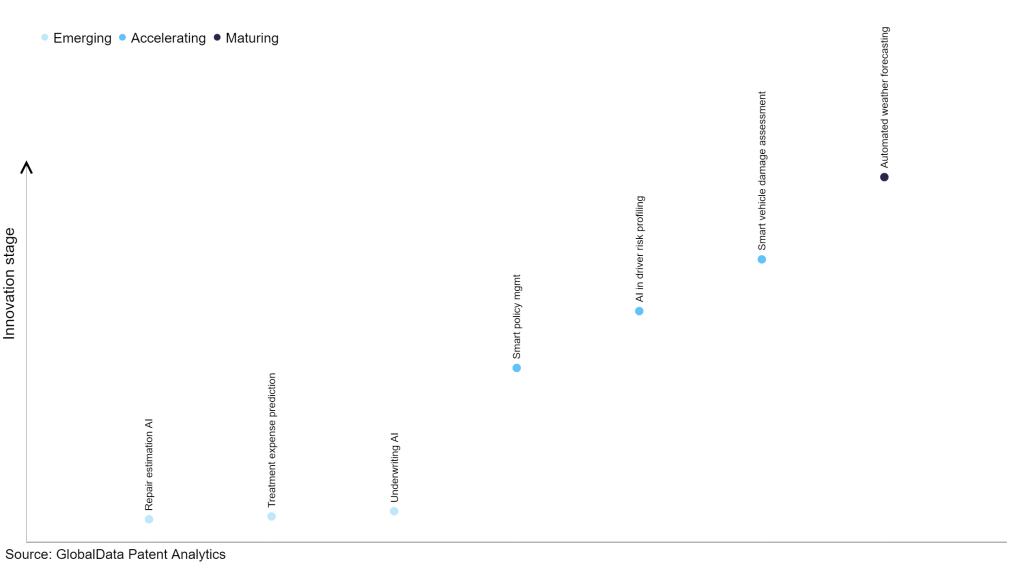
The insurance industry continues to be a hotbed of patent innovation. Activity is driven by digitalization, personalization, and growing importance of technologies such as artificial intelligence (AI), Internet of Things, and cybersecurity in insurance documentation and data analytics, predictive risk assessment, fraud detection, and smart policy management. In the last three years alone, there have been over 9,000 patents filed and granted in the insurance industry, according to GlobalData’s report on Artificial intelligence in insurance: AI-assisted underwriting. Buy the report here.
However, not all innovations are equal and nor do they follow a constant upward trend. Instead, their evolution takes the form of an S-shaped curve that reflects their typical lifecycle from early emergence to accelerating adoption, before finally stabilizing and reaching maturity.
Identifying where a particular innovation is on this journey, especially those that are in the emerging and accelerating stages, is essential for understanding their current level of adoption and the likely future trajectory and impact they will have.
25+ innovations will shape the insurance industry
According to GlobalData’s Technology Foresights, which plots the S-curve for the insurance industry using innovation intensity models built on over 75,000 patents, there are 25+ innovation areas that will shape the future of the industry.
Within the emerging innovation stage, repair estimation AI, treatment expense prediction and underwriting AI are disruptive technologies that are in the early stages of application and should be tracked closely. Smart policy management, AI in driver risk profiling and smart vehicle damage assessment are some of the accelerating innovation areas, where adoption has been steadily increasing. Among maturing innovation areas is automated weather forecasting, which is now well established in the industry.
Innovation S-curve for artificial intelligence in the insurance industry

Underwriting AI is a key innovation area in artificial intelligence
Underwriting AI refers to the use of artificial intelligence and data processing techniques by insurers to facilitate and ease the underwriting process. It involves analyzing and modeling data to assess risks, determine insurance premiums, and make informed decisions regarding policy approvals or rejections. By leveraging advanced algorithms and machine learning, underwriting AI enhances accuracy, efficiency, and automation in the underwriting process.
GlobalData’s analysis also uncovers the companies at the forefront of each innovation area and assesses the potential reach and impact of their patenting activity across different applications and geographies. According to GlobalData, there are 380+ companies, spanning technology vendors, established insurance companies, and up-and-coming start-ups engaged in the development and application of underwriting AI.
Key players in underwriting AI – a disruptive innovation in the insurance industry
‘Application diversity’ measures the number of applications identified for each patent. It broadly splits companies into either ‘niche’ or ‘diversified’ innovators.
‘Geographic reach’ refers to the number of countries each patent is registered in. It reflects the breadth of geographic application intended, ranging from ‘global’ to ‘local’.
Patent volumes related to underwriting AI
Source: GlobalData Patent Analytics
Ping An Insurance (Group) Company of China is one of the leading patent filers in underwriting AI. It has been at the forefront in utilizing advanced technologies such as AI, cloud, and big data to drive operational efficiencies, improve underwriting and claims management procedures, and minimize security risks. Ping An OneConnect is an AI-powered service platform for insurance companies to access and analyze large amounts of data from multiple sources quickly and accurately, and optimize risk control in underwriting and claim settlement.
State Farm Mutual Automobile Insurance, Taikang Insurance Group, and Alibaba Group are some of the other leading innovators in underwriting AI.
In terms of application diversity, Cox Enterprises held the top position, while Flex and Theator stood in second and third positions, respectively. By means of geographic reach, Expanse Bioinformatics leads the pack, followed by Tractable and Pictometry International.
To further understand the key themes and technologies disrupting the insurance industry, access GlobalData’s latest thematic research report on Artificial Intelligence (AI) in Insurance.






